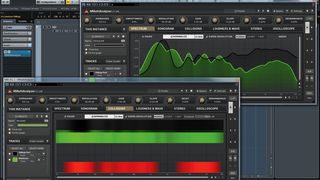8 pro tricks that will help you to reference your tracks more effectively
Compare your tracks to those of the professionals and elevate your mixes to the next level
Ever found that your latest banger sounds amazing in the studio but nowhere near as good as the best commercial tracks in your collection when played on the decks or in the car? We’ve all been there, and the a large part of the solution lies in the effective use of referencing during the mixing and mastering processes.
With this collection of referencing tips by your side, you're well equipped to make those dodgy mixes a thing of the past. And for more on referencing, the February 2018 of Computer Music should be your next port of call.

1. Successful A/Bing when EQing
When compressing a signal, we often need to bring the level back up with makeup gain after compression in order to make a fair comparison between the processed and unprocessed sounds - and a similar thing can happen with EQ. If you make a big EQ cut, be aware that the signal may have been reduced in level, so you might need to add a dB or two of makeup gain to match the volume between wet and dry signals.
2. A/B techniques when processing
The same A/B techniques used when mixing can also be effective for comparing processed and unprocessed signals within a track. For best results when using plugins, use your device’s output gain knob to match levels between wet and dry signals. Alternatively, a utility plugin can be used to juggle final levels, although you’ll find disabling that a bit of a pain when trying to make a quick A/B check with one mouse click.
Next, get used to punching your plugins on and off regularly, so you can carefully listen to what the processing is doing - use the plugin’s dedicated bypass (if it has one) to avoid unwanted clicks/pops that can happen when you use your plugin ‘container’’s bypass switch.
Finally, many plugins have an A/B feature, which lets you compare two different setups - this is an easy way to flick between EQ curves or compression settings, for example.

3. Frequency referencing
If you’re looking for a deeper way to analyse your mixes in comparison to reference material, why not try MeldaProduction’s MMultiAnalyzer? Load the plugin across multiple tracks and, once the routing is set up, compare the loudness, frequency spectrum and stereo spread between them in your DAW. You can also strap it onto individual tracks in the mix and use it to identify frequency clashes.
Get the MusicRadar Newsletter
Want all the hottest music and gear news, reviews, deals, features and more, direct to your inbox? Sign up here.
4. Reap the benefits of shortcuts
To make your life that bit easier, why not set up a few keyboard shortcuts to trigger the common tricks and tools you need when referencing? By mapping things like your reference track’s solo on/off, A/B switching in Magic AB 2, activation of your mono and mid/side plugins, and any filters you’ve applied to the master, it becomes second nature to make these checks while producing or mixing via the keyboard, rather than less-intuitive mouse clicks.
5. Batch processing
If you produce your music in batches, try rendering some volume-balanced short clips of your tunes and references (8-16 bars is fine) so you can listen to them easily in the car or on your phone. Put them on a USB stick or CD, or, if you’re listening on your phone or tablet, in a Dropbox folder, so you can quickly audition them without filling up your phone’s storage.
6. Crest practice
Alongside peak and RMS levels, another important thing to look at when referencing is the crest factor, which is a measurement of the difference between peak and RMS levels. A lower crest value indicates less dynamic range, with a crest factor of 1 meaning that there are no dynamics left at all.
7. Don't just trust the meters
While matching the average levels of a mix and your reference material, meters give a good starting point, but you might still find that the tracks don’t sound properly balanced volume-wise, due to excessive bass or brightness. Because of this, always make your final adjustments by ear to get a precise and more useful comparison.
8. Reference on a grand scale
If you’re making club music, there’s no substitute for hearing it thumping out of a massive sound system. With this in mind, why not bribe your local club’s sound engineer with their favourite tipple so you can go and audition your volume matched mixes and references on the PA before opening time? Press play, then get on the dancefloor for a punter’s perspective on those clangy rides you’re worried about. Do remember that the sound won’t be quite the same as when there are bodies in the room, though.
Computer Music magazine is the world’s best selling publication dedicated solely to making great music with your Mac or PC computer. Each issue it brings its lucky readers the best in cutting-edge tutorials, need-to-know, expert software reviews and even all the tools you actually need to make great music today, courtesy of our legendary CM Plugin Suite.

"If I wasn't recording albums every month, multiple albums, and I wasn't playing on everyone's songs, I wouldn't need any of this”: Travis Barker reveals his production tricks and gear in a new studio tour

“My management and agent have always tried to cover my back on the road”: Neil Young just axed premium gig tickets following advice from The Cure’s Robert Smith











